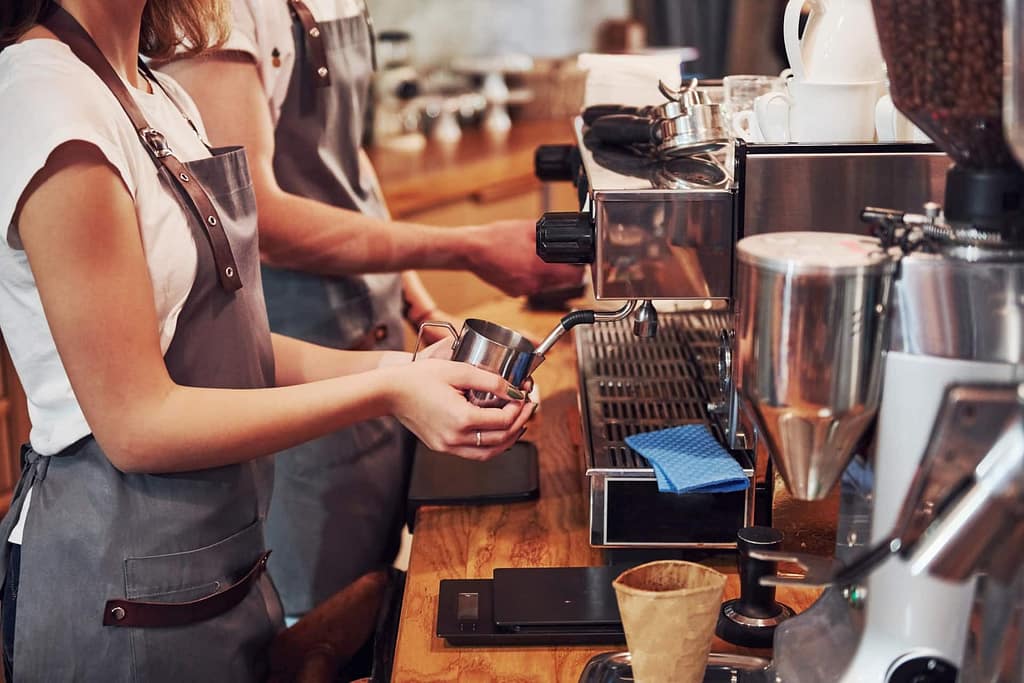Mia Munch of UCC explains how to maximise a café’s workflow without rushing through service.
Walking into any bustling coffee shop, you’ll witness a flurry of activity that seems almost choreographed. It’s an intense high-pressure environment that can easily overwhelm newcomers. Amid this chaos, many baristas find themselves swept up in the frenzy, striving to churn out drinks as quickly as possible. As a barista trainer for UCC Coffee who has worked with baristas all over Australia of varying skill levels, I have seen this firsthand. Even the most seasoned veterans can struggle to keep up with the morning rush. At first glance, it might seem the key to success in such an environment is to work faster, to move with urgency and avoid any sense of delay. However, there is a hidden cost to this approach, and it often leads to sub-par coffee.
Lesson 1: Take your time
Rushing reduces the amount of time available for thinking and attending to the finer details. Making coffee is a precise process and there is typically not much room for error. When hurrying through the coffee making process, you are more likely to make mistakes, which take time to fix. For example, spilling coffee grinds while dosing or knocking the group handle, which can create cracks in the puck, may lead to incorrectly extracted shots. Not only does this affect the quality of flavour in the cup, but you might also have to discard the espresso or milk and start over, wasting both resources and valuable time. Spending 30-45 seconds to re-do a shot might not seem like much in the moment, but when making hundreds of coffees over the course of the morning, this number adds up fast. Making mistakes is inevitable, we are human after all, but without the correct structures in place mistakes can lead to lower-quality coffee and longer-wait times for customers.
Speeding through service may also lead you to skip necessary steps in your workflow such as cleaning. When rushing, it is easy to make messes while dosing, tamping, pouring milk and dusting chocolate powder on cappuccinos. It may also be more challenging to keep an organised workspace. While a disorganised and messy workstation may not seem to impact the coffee being served, it will greatly affect your workflow. Forgetting to put your tools back where they belong will waste time in the long run, as you will now need to spend a few seconds searching for them before your next coffee. Spillages of coffee grinds, hot water or milk will exacerbate this. Not only this, but there is vital cleaning required between every coffee that will affect the flavour in the final cup. Forgetting to purge the group head or wipe the filter basket between shots can lead to old coffee grinds affecting the flavour of each espresso served. Not rinsing your milk jugs or wiping the steam wand may lead to burnt-tasting milk. The result is a lower quality coffee for the customer.
These a just a few examples of how rushing can be detrimental to workflow and coffee quality, and therefore customer satisfaction. Customers are the backbone of every café, without them there wouldn’t be a business to run. Keeping customers happy is vital as it will increase profits, the brands reputation, and ultimately lead to long-term success.
Lesson 2: finding balance
Finding the right balance between quality and speed can be very tricky, particularly when it’s busy. It’s very easy to prioritise speed to the point where quality is sacrificed. After all, it’s easy to cut corners when you’re stressed, sometimes it might even feel necessary. But it isn’t. I truly believe it takes the same amount of time to make a good coffee as it does a bad one, the difference is in how you do it. The key is slowing down. Taking your time and maintaining a focused, methodical approach can help reduce the likelihood of making mistakes and skipping unnecessary steps. This reduces the need for corrections which ultimately saves time and improves the quality of every coffee served.
Lesson 3: quality over quantity
Perhaps the most important lesson I’ve learned as a barista trainer is that quality should always be your top priority. When you prioritise quality, speed naturally follows as a result of consistent practice and a refined workflow. It’s much harder to add on quality when you are already going fast. Take the time to fine-tune this in your workflow. Think about what you are doing and identify areas you can be more efficient. Remember, efficiency is not just about speed; it is also about reducing mistakes and maintaining quality.
Lesson 4: increase workflow efficiency
The workflow of each barista can be broken down into a series of steps. Each step will take some time to complete, and some steps can be completed simultaneously to save time. For example, purge the group head immediately after removing the handle while waiting for the grinder to grind out your dose, rather than after loading your handle and tamping it. Develop a natural flow that maximises your productivity without feeling rushed and stick with it. Make sure you complete each step properly before moving on. It might feel like you are taking longer at first, especially as you adjust to your new rhythm, but doing things correctly and efficiently the first time will save time in the long run. Consider it an investment in the quality of your product. For example, if you tamp unevenly, take the few seconds to redo it before extraction. It might feel like you’re wasting time, but it’s faster than re-doing an entire incorrect shot after it extracts incorrectly. If you spill something on the bench clean it up straight away rather than letting it all pile up. The time you spend cleaning will be nothing compared to the time you lose searching for things in a chaotic environment.
As a barista, the art of slowing down can seem like a paradox in a world that values speed and efficiency. However, it is essential to recognise that quality and customer satisfaction should never be sacrificed in the pursuit of speed alone. By embracing a more measured approach, you can achieve precision, consistency, and efficiency that will ultimately make you a faster, more effective barista.
This article appears in the December 2023 edition of BeanScene. Subscribe HERE.


